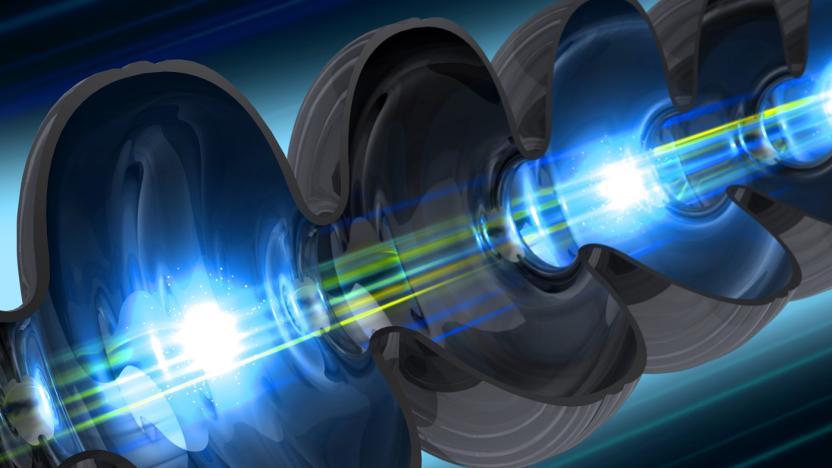x-raylaser
Latest

X-ray laser spots photosynthesis in real-life conditions
Humanity has known about the life-giving photosynthesis process for a long time, but studying it in real-world conditions has often been impractical. You've typically had to freeze samples to get a good look, which isn't exactly natural. However, the SLAC National Accelerator Laboratory just managed a breakthrough: it used its x-ray laser to capture detailed snapshots of photosynthesis at room temperature. The trick was to place protein complex samples in a solution, put that on a conveyor belt, light it up with a green laser (to start the water-splitting reaction) and capture images using x-ray pulses. As those pulses are extremely fast -- just 40 femtoseconds long -- you can collect crystallization and spectroscopy data before the sample meets its untimely end.

World's most powerful X-ray laser will get 10,000 times brighter
If you think that Stanford's use of an super-bright X-ray laser to study the atom-level world is impressive, you're in for a treat. The school and its partners have started work on an upgrade, LCLS-II (Linac Coherent Light Source II), whose second laser beam will typically be 10,000 times brighter and 8,000 times faster than the first -- up to a million pulses per second. The feat will require an extremely cold (-456F), niobium-based superconducting accelerator cavity that conducts electricity with zero losses. In contrast, the original laser shoots through room-temperature copper at a relatively pedestrian 120 pulses per second.

The Big Picture: The world's most powerful x-ray laser
This is a photo of the Linac Coherent Light Source or LCLS -- an x-ray free-electron laser in Stanford University's SLAC National Accelerator Laboratory. It's also dubbed as the most powerful x-ray laser in the world. The SLAC Lab took a group of amateur and pro photographers on a tour of its facilities, giving them the chance to shoot photos of both the LCLS and the Stanford Synchrotron Radiation Lightsource (SSRL) for a contest. This image captured by Nathan Taylor is one of the top three entries taken by people from the group and will be submitted to this year's Global Physics Photowalk, which aims to show behind-the-scenes photographs of the world's leading particle physics laboratories. You can see all the winners, including another winning picture by Daniele Fanelli that features toy dinosaurs, along with the other entries that got honorable mention on SLAC's website. [Image credit: SLAC National Accelerator Laboratory/Nathan Taylor]

Diamond hones DOE X-ray laser howitzer to razor-sharp precision
The US Department of Energy's SLAC accelerator lab already has a pretty useful X-ray laser -- the Linac Coherent Light Source (LCLS). But, recent modifications to the device have scientists drooling over its new found potential. Using a thin wafer of diamond, the Stanford-run lab filtered the beam to a lone frequency, then amplified it in a process called "self-seeding." That's given the world's most powerful X-ray laser even more punch by tossing out unneeded wavelengths which were reducing its intensity. The tweaks allow scientists across many fields to finesse and image matter at the atomic level, giving them more power to study and change it. According to the lab, researchers who came to observe the experiment from other X-ray laser facilities "were grinning from ear to ear" at the possibility of integrating the tech into their own labs. The SLAC team claims they could still add 10 times more punch to the LCLS with further optimization, putting the laser in a class by itself -- X-ray-wise, anyway.

German scientists shoot world's fastest movie: gone in 50 femtoseconds
No, it's not another Fast & Furious sequel, it's something much quicker -- 800 billion times quicker, to be precise. Scientists at DESY (Germany's largest particle physics center) are premiering the Guinness World Record-holding fastest "movie" to a select audience at its light sources users' meeting. The film was shot using an X-ray Laser, and splitting the light in two. By firing one beam off on a minuscule detour (0.015 millimeters) and delaying its arrival by 50 femtoseconds, two separate images are captured. Okay, so two frames isn't exactly Lord of the Rings, but it's still the smallest interval ever recorded. This technique won't be popping up in Hollywood any time soon -- instead, it's actually used for snapping subatomic glimpses of ultra-fast molecular processes and chemical reactions. Despite the brevity of this record-breaking flick, the plot is apparently still more complex than Tokyo Drift.



